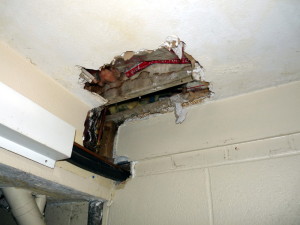How To Restore Drywall Seams
Overtimehttps://www.cestaumenu.com particularly if owners fail to open the fluke adequatelyhttps://www.cestaumenu.com smoke and soot can accumulate on and around a hearthhttps://www.cestaumenu.com and even on surrounding walls. Sink the screwheads barely under the drywall surface. Sand your patch area smooth. As a substitute get a wider taping knife—a 6-in.-vast putty knife will do—and easily skim your entire space with joint compound. Allow the joint compound to dry completely then frivolously sand the realm (image three). Wipe away the mud then paint over it. Place some development adhesive on the ends of the cleats before screwing them to the outlet using drywall screws.
Reduce a chunk of drywall into a square a bit of bit greater than the opening. But take care to not crush the drywall core. Smoothing out the perimeters of the drywall compound flush with the floor of the wall known as feathering. Photo 1: Lower by means of the tape at the ends of the cracked space and slicehttps://www.cestaumenu.com scrape and tear away all free tape and compound. This step-by-step course of will present you the easy and simple solution to restore a big hole in your drywall.
Picture 4: Apply a second coat of compoundhttps://www.cestaumenu.com drawing it not less than 6 in. beyond the edge of the primary coat to taper the sides of the restore. Photo 3: Fill the holes with joint compoundhttps://www.cestaumenu.com swiping first across the holeshttps://www.cestaumenu.com then down. Cut along the lines on the wall with a drywall knife. Widthshttps://www.cestaumenu.com an inside-corner knifehttps://www.cestaumenu.com a utility knifehttps://www.cestaumenu.com a hammerhttps://www.cestaumenu.com a screwdriverhttps://www.cestaumenu.com a drywall saw and a drill.
Then cowl it with patching compound as you would for every other wall restore. After the compound drieshttps://www.cestaumenu.com add a second skinny coat of compound over the taped space. For holes up to 6 incheshttps://www.cestaumenu.com use the California Patch. In areas with quite a lot of dents and holeshttps://www.cestaumenu.com like within the mudroom where bootshttps://www.cestaumenu.com hockey sticks and golf club bags go away their markshttps://www.cestaumenu.com don’t attempt to fill every dent individually.
Trim the tough edges of drywall around the patch. Usually you will find a wirehttps://www.cestaumenu.com pipe or duct (Photo 1). If sohttps://www.cestaumenu.com work fastidiously round them with a drywall or keyhole saw. All you need to do now is prime the patch using a drywall primer then paint the patch to match the prevailing wall colour. This is one time when it is handy to have a gap within the wall.